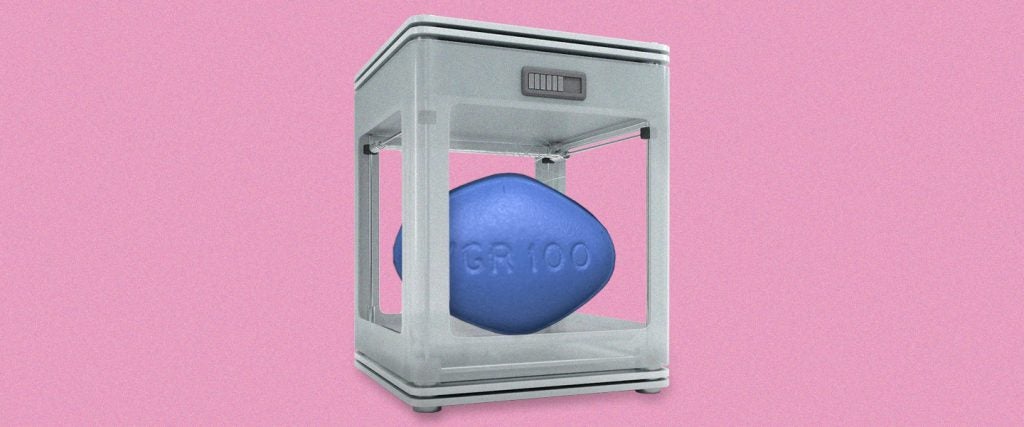In 2015, the Food and Drug Administration (FDA) gave its official stamp of approval to a 3D-printed drug for the first time ever. It was a prestigious honor — it took until last year for the second 3D-printed medication, a rheumatoid arthritis treatment named Triastek, to be cleared. The drug in question is Spritam, an epilepsy medication designed to dissolve on your tongue almost instantly. The nuts and bolts of the science are pretty complicated, but essentially, Spritam is manufactured by spraying a liquid binder solution with an inkjet printhead over a thin layer of powder — known as a “powder bed” — over and over again, until the pill is fully formed.
Jargon aside, these tiny white pills have led scientists worldwide to tinker with other medications to see if they could also be 3D printed. But why would anyone bother?
According to a group of researchers in China, there are a handful of key advantages to 3D printing pharmaceuticals. Not only can the process enable personalized doses, changing the shape and structure of pills can allow more control over how quickly the drug is released into the body. Researchers note that it can “also print loose porous pills to reduce swallowing difficulties,” a key selling point of Spritam.
Unlike Spritam, though, there’s one drug being experimented with that you’ve definitely heard of: sildenafil, commonly sold under the brand name Viagra. These “blue diamonds” are usually prescribed at a starting dosage of 50 milligrams, but sildenafil — the active ingredient — can also be prescribed in low-dosage pills, sold under the brand name Revatio. When the dosage drops to 20 milligrams, sildenafil can be provided to kids under the age of 18 to treat pulmonary hypertension, a lung condition that can cause serious long-term heart damage if not treated. It’s a prescription decision that’s proven controversial, however — in 2017, the FDA put out an official safety warning discouraging the prescription of sildenafil to minors, citing stats that linked high doses to high mortality rates.
Curious to see whether 3D printing could help to personalize these dosages of sildenafil even further — which would help reduce unwanted side effects — a group of Belgian researchers wrote a quality control report of existing 3D-printed sildenafil tablets last year. Essentially, it proved the hypothesis that lower temperature printing techniques lead to safer, more personalized doses, and indicated that 3D printing sildenafil on a larger scale could be possible.
Admittedly, it’s a field that’s still in its extremely nascent stages, but the report begs another key question: Could the future be full of 3D-printed dick drugs?
To dig deeper, I reached out to KD of KINK3D, whose 3D printed cock cages are sexy, customizable works of art. They haven’t heard murmurings of these futuristic dick drugs just yet, though. “The closest I’ve heard is the 3D printing that’s used in molecular gastronomy to make chocolate desserts,” they tell me.
I show KD the Belgian researchers’ paper to gauge their thoughts, and KD seems to be on-board with the potential of 3D-printed sildenafil. “It doesn’t surprise me at all that it’s being trialed,” they say. “First, there are lots of pharmaceuticals with expired patents or soon-to-be-expired patents, and coming up with new, patentable delivery mechanisms for those generic drugs is a huge profit center. Second, one of the main advantages of 3D printing in traditional manufacturing is that it allows relatively cost-effective customized production rather than mass runs of identical products. I would imagine the same applies in pharmaceuticals, where there’s currently a lot of interest in customizing interventions targeted for the individual patient rather than a one-size-fits-all pill.”
So that’s what’s in it for pharmaceutical companies, but what about at-home printing? Realistically, it’s hard to imagine — to pull it off would require immense amounts of expertise, ingredients and equipment, and any at-home pharmaceutical printing would likely come with heavy regulation. However, if the horny potential of 3D-printed pharmaceuticals was to be realized, it’s theoretically possible to toy with dosages and release rates to give yourself the perfect slowly growing boner that lasts even longer.
The possibilities are endless, but they’re also expensive and wildly ahead of the actual science. “Three or four years ago, the fear that in the near future, everyone would print their own unregulated drugs was pretty widespread,” says Brad, a pseudonymous 3D-printing professor. “Fast-forward to today and we’re still prototyping how to print chocolate! The idea of a system capable of 3D printing drugs seems far away and not so practical, considering the amount of chemistry involved in the process.”
Another 3D-printing professor says that these futuristic boner pills would require a lot of labor for not much payoff. “It’s what I would describe to my students as a ‘bluetooth sandwich,’” he tells me, also asking to remain anonymous. “Nobody needs a sandwich with bluetooth, it just doesn’t fundamentally add value to the use case.” Because there are other, cheaper ways to control drug concentration — and the control over drug concentration is the most-cited argument in favor of 3D printing medication — he argues it’s not worth it.
A world of custom dick drugs might be a long way off, but it is worth noting that Viagra is a seriously lucrative cash cow. The world of medicine takes boners extremely seriously, so nailing the patent for a functioning, 3D-printed dick drug could be a real boon for some noble researcher looking to bring more erection pills to the market. But until this horny hero comes along, boner tablets aren’t even on the radar of most 3D-printing buffs. It’s probably for the best, too — if we can’t even perfect 3D-printed chocolate, it’s advisable to stick to those trusty blue diamonds for now.

